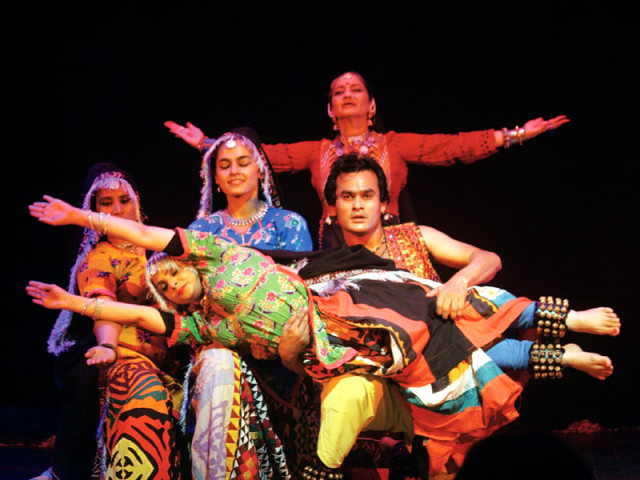International Dance Day: An ode to dance
Sheema Kermani performed to enchanting poems with her students, putting up an incredible show.

Kermani performed on splendid tunes and proved herself once again, she also turned out to be an outstanding mentor. PHOTO: ATHAR KHAN/EXPRESS
Imagine the surprise, when we find ourselves completely speechless after experiencing one of the most exhilarating performances — a dance performance that steals your heart away with just a few steps and with poetry of some of the best works of renowned poets in sync with it.
Undoubtedly, you are ecstatic and at the same time in deep pain if you understand the true meaning of the act altogether. That was the charm of Sheema Kermani and her troupe at a dance performance, combining some of the best folk, classical, Odissi* and Kathak* steps. The performance took place on April 29 at the Arts Council Auditorium, Karachi, celebratingthe International Dance Day.
Beginning the first dance performance on Sheikh Ayaz’s poem, The Song of the Thirsty Peacock, Kermani portrayed what it is like to be in chains and how to claim ones right to freedom through her dance moves by calling out for freedom and liberation, at a high note. The music of this was an original composed by Sajjid Hussain, the well-known composer and sitarist.
The troupe also performed on Rabindranath Tagore’s poem, Dhole Dhole, the performance was comparatively average.
The third performance was a of Kathak dance to a Tarana in Raga Kalavati. Performed by Mohsin Baber in the lead and three other female students. Baber needs a special mention for his performance; with the flowing dance steps to the engaging hand gestures, it was a feast for the eyes to see.
For Kermani herself, her dance steps were relatively calculated now, before, she would step on the stage with the persona of a young girl, now, her steps are comparatively risk-free, nonetheless they didn’t fail. From Amir Khusrau’s collection came three splendid works; a ghazal named Zihal-e-Miskeen, a geet named Chaap Tilak and a qawalli named Aaj Rung Hae. Her solo dance performance incorporated moves from different forms of classical dance genres namely Kathak, Bharata Natyam* and Odissi
Kermani surely did justice to the work of Khusrau in dancing away on the same note therein, gesturing with her doe-eyes on Chaap Tilak. Her moves are evident of the fact that she considers dance not just as a performing art, but beyond that — something spiritual. Rung too captured an essence that was long lasting and mesmerising; it was one flamboyant performance.

The finale of the evening were the traditional dances from the coastal areas of Sindh and Balochistan. The music and the choreography of the entire evening was all Kermani’s original work.
On a final note, though Kermani performed on splendid tunes and proved herself once again, it was evident that she is an outstanding mentor; it was her students who impressed the audience.

Odissi, also known as Orissi, is one of the eight classical dance forms of India. It originates from the state of Odisha, in eastern India. It is considered to be the oldest surviving dance form of India on the basis of archaeological evidences.
Bharata Natyam is another form of classical Indian dance that originated in the temples of Tamil Nadu. Bharata Natyam dance moves are known for their grace, purity, tenderness, and sculpturesque poses.
Kathak is a Indian classical dance form that traces its origins to the nomadic bards of ancient northern India, known as Kathakars or storytellers. Its form today contains traces of temple and ritual dances, and the influence of the bhakti movement.
Published in The Express Tribune, May 1st, 2014.
Like Life & Style on Facebook, follow @ETLifeandStyle on Twitter for the latest in fashion, gossip and entertainment.



















COMMENTS
Comments are moderated and generally will be posted if they are on-topic and not abusive.
For more information, please see our Comments FAQ